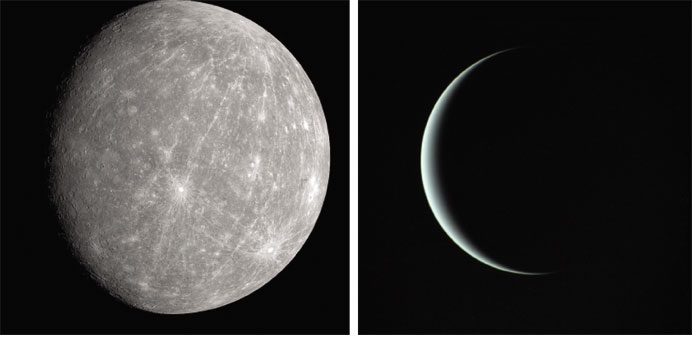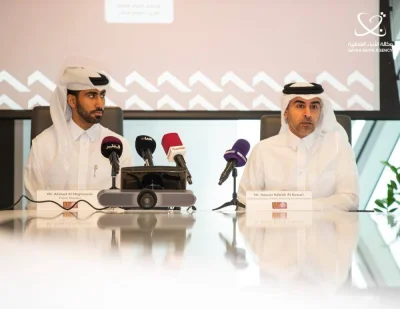STARRY NIGHT: Images of Mercury, left, and Uranus, as seen in the film.
The journey through the cosmos started with the triumphant firepower of Mars before navigating through the many moods of our galactic neighbours against the backdrop of western classical pieces, writes Anand Holla
Given how little we understand or can relate to the planets in our universe, developing any sort of connection with them would be a case of asking for the moon. So when The Planets: An HD Odyssey descended on Doha by blending awe-inspiring images from space with genius British composer Gustav Holst’s cosmic masterpiece, The Planets, it was both truly and figuratively an out of this world experience.
Purely for its significance — the Qatar Philharmonic Orchestra (QPO) performed the Mena (Middle East and North Africa) premiere of this popular presentation — it was one of the year’s biggest music concerts. The second half of the show was no less a wonder. Carl Orff’s Carmina Burana was all set to sweep the audience off their feet with its grandeur.
And what only added to the show’s debut memory was the phenomenal footfall — an audience of around 1,700 — at the Qatar National Convention Centre.
In the performance helmed by conductor Alastair Williams, the backdrop for Holst’s best-known orchestral suite The Planets couldn’t have been more epic. On a giant screen over the stage, filmmaker Duncan Copp’s The Planets: An HD Odyssey played the latest high-definition NASA images from modern space exploration of the solar system.
It was when the orchestra plunged into Holst’s score with the marching band-meets-war drums rhythm of Mars, The Bringer of War, that the beauty of this aural-visual spectacle sunk in. Abstract visuals of rocky, pock-marked surfaces of unfamiliar landscapes seemed naturally in tune with the overwhelming dynamism of Holst’s western classical pieces.
A journey through the cosmos that started with the triumphant firepower of Mars, navigated through the many moods of our galactic neighbours: Venus, the Bringer of Peace; Mercury, the Winged Messenger; Jupiter, the Bringer of Jollity; Saturn, the Bringer of Old Age; Uranus, the Magician; and Neptune, the mystic. Pluto didn’t figure as it wasn’t discovered then.
Since Holst’s music explored the magnificence of space and the mythology of the solar system, it was interesting to see how those elaborate pieces composed a century ago (Holst created The Planets in 1914-16) melded almost seamlessly with the actual and the latest high-definition pictures of various planets.
Being an astrology lover, Holst had distilled his understanding of the astrological associations into his arrangements, which have often been stolen or re-interpreted by films and television productions over the years.
The dramatic, flowing symphony for the largest planet Jupiter, for instance, went really well with the images of wayward clouds. Visuals taken from rovers and satellites, and even radar images and computer-generated-graphics, were combined to match with the orchestra’s rhythm and melody.
For now, it was perhaps the closest we could get to floating above planets and admiring their barren yet amazing stretches of landscape.
As for Venus, many critics have pointed out how Holst may have misinterpreted Venus’ real personality. While his piece is serene and soothing, perhaps going by the mythology of Venus as the goddess of love, the truth is that it is extremely hostile and hot. A NASA scientist is said to have remarked that Holst had “no idea that Venus was such a hellish place.”
While Uranus left a lot to our interpretations, Neptune sounded as mysterious as it seems, ending with a rousing offstage women’s chorus.
As the orchestra soaked in the audience’s applause and stepped off the stage, Jill Dutcher, who sat to the left of the stage and operated the system that controlled the scenes and synchronised the performance, looked excited. “Everything went really well. I can’t be happier,” she said, smiling.
“The screen is behind the orchestra so that the conductor could see the images as he conducted the performance,” Dutcher said. The top quality images seen on screen throughout the concert are courtesy “hot stacking,” which means two projectors continuously beamed the images together.
But nothing would work like magic if Dutcher wouldn’t pay close attention to the conductor’s score. “There is no click track or any such thing. But I have cues in my score,” she said, leafing through a thick book of notations of The Planets.
“So I will change the visuals when we get to those cues, which makes this process so organic. This is what Copp and music director Hans Graf had in mind when they started this project; you know to make it truly organic and get the images to compliment the music rather than distract it. This way, the images become another musician for the conductor, but a musician who can express visually and not with sounds,” said Dutcher.
But why go through the trouble of playing around with the cues when the whole film can be run at once? Dutcher explained, “Every maestro has a different tempo (speed at which the music must be played). They could let some sections play on for longer or shorter durations. They are freer to interpret the music, without being bound to the film’s length.”
So while the film’s sequence of visuals is mostly pre-determined, Dutcher calls the shots on exactly how much and when to move forward or stop. “We need to accommodate all the various interpretations of the music. To do so requires a lot of co-ordination. For instance, at the end of the Mars piece, there is a blackout, where the conductor can rest as long as he wants to.”
Dutcher needs to have terrific observational skills as it is only through eye contact that she can catch the conductor’s subtlest of cues. “Usually, I am sitting in a distant booth, with headphones on. This is the first time I have sat so close to the orchestra, and it’s great to have that connection here and also be part of the performance.”
Even for the orchestra, it had been a tough three days. “They began rehearsing for The Planets performance on Thursday, and did a fabulous job,” Dutcher said.
The Wisconsin resident is a pianist and a stage manager for opera when she isn’t busy being the Technical Manager of The Planets: An HD Odyssey, North America and the Middle East. Of all the things here, she found the professionalism special. “The hardest part for us is when we are hooking up our system with the system that the theatre has rented, because every building has different equipment,” she said.
“However, in Doha, they have highly trained professionals at work and setting up time here was the shortest. And the equipment is so state-of-the-art that I want to take them home with me,” she said and laughed.
That should certainly be reason enough for her team to return to Doha? “We have another glorious project called Earth: An HD Odyssey, which has beautiful images of Earth taken from NASA’s missions. We would be happy to bring that here,” Dutcher said.
One striking image from the film Earth: An HD Odyssey made for the backdrop of the second part of the show — the Carmina Burana performance. And that still shot alone looked like a wonderful indication of the beauty that is still to come in this odyssey.
BELOW:
1) AT THE HELM: Conductor Alastair Willis directs a musician to play a brief solo section during the performance. Photos by Jayaram
2) MUSIC UNLEASHED: The Qatar Philharmonic Orchestra weaving their magic on the audience as The Planets concert begins at QNCC.



